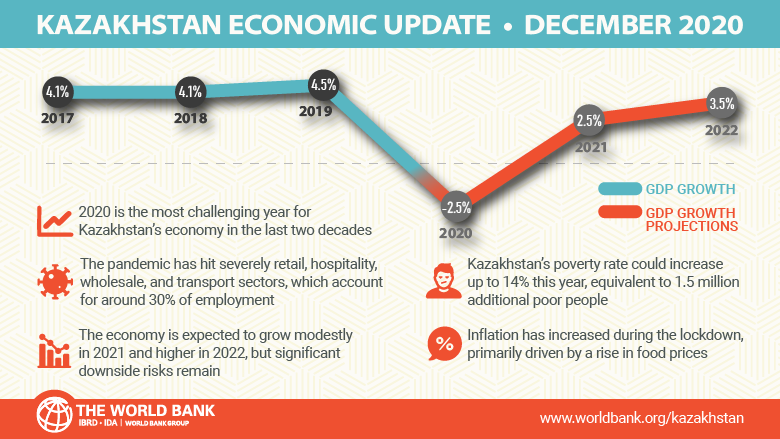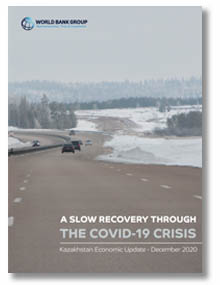The fallout of the COVID-19 pandemic has hit the economy more than the crises in 2008 and 2015. The pandemic halted global activity in the second quarter of 2020, and depressed global demand and price of oil, which is Kazakhstan’s main export commodity. In April 2020, the average oil price dropped to $21 barrel, the lowest in the last two decades.
More importantly, COVID-19 also has caused invaluable losses of human lives. Official figures show that in mid-December 2020, COVID-19 caused around 2,626 deaths, which is 1.4 percent of confirmed cases. Given the country’s population size, these deaths, directly or indirectly related to COVID-19, constitute a tragedy that almost every person in Kazakhstan can relate to.
The pandemic also significantly depressed domestic economic activities in 2020. GDP contracted by 2.8 percent over January-September 2020, compared to a 4.1 percent increase in the same period of 2019. The size of this economic contraction is significant because despite an economic uptick in the third and fourth quarters, the economy is still projected to shrink by 2.5 percent in 2020.
This report estimates Kazakhstan’s poverty rate will increase to 12-14 percent in 2020 from a baseline of 6 percent in 2016. The pandemic has hit severely retail, hospitality, wholesale, and transport sectors, which account for around 30 percent of employment, and are mostly concentrated in cities. However, the most significant increase in the number of the poor is expected to come from rural areas, which can increase inequality in Kazakhstan.
The authorities introduced a substantive amount of direct support to firms through tax deferrals and subsidized loans, and financial support to poor households and affected individuals. Subsidized loans for working capital were also introduced to minimize default in payments on salaries and suppliers by SMEs. Less than one month after declaring a nationwide emergency in mid-March, the government deployed a cash-support program through on-line transfers to around 4.6 million recipients (24 percent of the population).
The economy is expected to grow modesty by 2.5 percent in 2021, based on an improved global economic outlook, higher demand for exports, resumption of domestic economic activities, and higher disposable income. However, successful implementation of COVID-19 vaccines will further boost market sentiment and economic activities in 2021 and support higher growth in 2022.
Nevertheless, there are significant risks because of uneven economic recovery across countries due to the protracted pandemic and higher debt-related risks to the global financial market. Although the global oil price has regained some ground, the ample global oil reserves and OPEC+ commitment to limit production can limit Kazakhstan’s oil export revenues. The domestic financial sector is also exposed to a higher risk of growing non-performing loans if support measures are withdrawn.
There are also emerging challenges, such as weaker global demand for fossil fuels, a higher regional competition to attract investments, higher risks of instability in the financial sector, and more need for accountable and transparent governance.
Kazakhstan needs more reforms to sustain economic recovery because average GDP growth has declined after each economic crisis, weighed down by the lackluster growth in productivity and over-dependency on hydrocarbons. The authorities have stepped up efforts to renew reform momentum. In his Annual Address in September, the President stressed the need for policy changes to confront “a new reality” and has taken steps to initiate reforms. It will be important for the authorities to show a commitment to address the long-standing problems that diminished productivity growth and establish a solid foundation for economic recovery.

